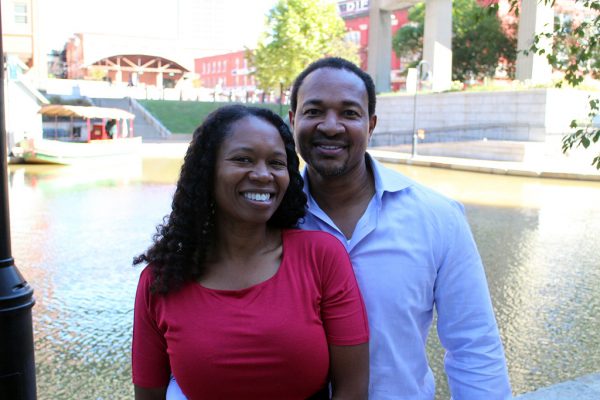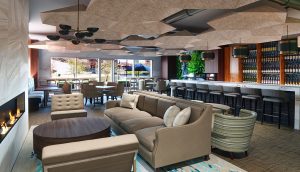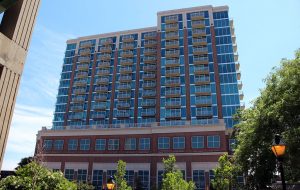Two investors are making their first splash into the restaurant business, with a new venture in the works on the ground floor of a downtown condo tower.
Bateau, a new wine bar and coffee shop, is set to open along the canal level of the Vistas on the James building at 301 Virginia St.
Owners Arvat McClaine and Harry Watkins, who typically have invested in educational and health care ventures across the state, are targeting a December opening.
Bateau will serve a variety of coffee blends, white and red wines, Watkins said, and wine-infused coffee. It also will offer a small breakfast, lunch and dinner menu that is being crafted with the help of local chef and Spoonbread Bistro owner Michael Hall.
Watkins and McClaine are gathering wines from several California-based African-American vintners, including recording artist John Legend’s LVE Wine and NBA player Dwyane Wade’s D Wade Cellars. Bateau also will include wines from South Africa, Italy and France, and is working to secure a distributor to bring in wines from a few Virginia wineries.
Leipertz Construction is the general contractor handling construction on Bateau’s space. Helen Reed Design is the interior designer, while Johannas Design Group is the architect. PermitZip is doing the mechanical, electrical and plumbing drawings.
Upon completion, the 1,400-square-foot restaurant will seat 49 and include patio seating along the canal.
The name Bateau, which means “boat” in French, is a tribute to the history of the region’s river navigators – known as bateaumen – who helped shape commerce across the commonwealth during the 18th and 19th centuries.
Their importance to Richmond is reflected in the city’s flag since its redesign in 1993, in the form of a replica of a bateaumen navigating the James River.
“Many of the bateaumen transported goods like tobacco, coffee and spices in these shallow river crafts along the James River, which took serious skill and knowledge given the currents of the river,” Watkins said.
About 95 percent of the bateaumen were freed and enslaved black men, Watkins said. At their peak, he said there were about 1,500 bateaumen in the Richmond region – all hauling goods on about 500 boats between the capital city and the Peninsula region of Hampton Roads.
During the Civil War, Watkins said the bateaumen were drafted mainly by the Confederate Army to bring goods to the soldiers and to fight. But the men rarely were called upon for their extensive knowledge of the region’s waterways, Watkins said.
“It’s believed the Confederate Army lost the war because they refused to utilize the river navigation skills of the bateaumen,” he said.
McClaine said they hope Bateau will continue educating the public about the legacy of the region’s famed watermen, and they’re considering ideas about how best to do it.
“We’ve thought about placing messaging on the coffee cup sleeves, and certainly through the decor of the space,” McClaine said.
As part of Bateau’s design, Watkins said a mural of the Headmen statue on Brown’s Island will be painted in the establishment. He added the location also is slated to be added to the American Civil War Museum’s History Happy Hour circuit, which plans to host history professors from VCU and Hampton University to discuss the bateaumens’ legacy and history in the region.
Bateau also will offer live jazz music on Tuesdays and Fridays, as well as a “Blue Note” series on Saturdays that will feature the music of a single jazz artist.
Within walking distance of the American Civil War Museum, Richmond Slave Trail and Richmond Slavery Reconciliation Statue, Watkins wants Bateau to be an accessory to the history museums in the area. He and McClaine are working on securing a historical marker for the bateaumen to be placed along the canal walk.
“This is more than just coffee and wine … this is a teachable moment for everyone,” Watkins said.
With the opening set in about 2 1/2 months, the pair wants Bateau to be destination, with no plans to open a second location.
“This is it,” Watkins said. “We want this to a showcase for the canal and the history that surrounds this location.”
Two investors are making their first splash into the restaurant business, with a new venture in the works on the ground floor of a downtown condo tower.
Bateau, a new wine bar and coffee shop, is set to open along the canal level of the Vistas on the James building at 301 Virginia St.
Owners Arvat McClaine and Harry Watkins, who typically have invested in educational and health care ventures across the state, are targeting a December opening.
Bateau will serve a variety of coffee blends, white and red wines, Watkins said, and wine-infused coffee. It also will offer a small breakfast, lunch and dinner menu that is being crafted with the help of local chef and Spoonbread Bistro owner Michael Hall.
Watkins and McClaine are gathering wines from several California-based African-American vintners, including recording artist John Legend’s LVE Wine and NBA player Dwyane Wade’s D Wade Cellars. Bateau also will include wines from South Africa, Italy and France, and is working to secure a distributor to bring in wines from a few Virginia wineries.
Leipertz Construction is the general contractor handling construction on Bateau’s space. Helen Reed Design is the interior designer, while Johannas Design Group is the architect. PermitZip is doing the mechanical, electrical and plumbing drawings.
Upon completion, the 1,400-square-foot restaurant will seat 49 and include patio seating along the canal.
The name Bateau, which means “boat” in French, is a tribute to the history of the region’s river navigators – known as bateaumen – who helped shape commerce across the commonwealth during the 18th and 19th centuries.
Their importance to Richmond is reflected in the city’s flag since its redesign in 1993, in the form of a replica of a bateaumen navigating the James River.
“Many of the bateaumen transported goods like tobacco, coffee and spices in these shallow river crafts along the James River, which took serious skill and knowledge given the currents of the river,” Watkins said.
About 95 percent of the bateaumen were freed and enslaved black men, Watkins said. At their peak, he said there were about 1,500 bateaumen in the Richmond region – all hauling goods on about 500 boats between the capital city and the Peninsula region of Hampton Roads.
During the Civil War, Watkins said the bateaumen were drafted mainly by the Confederate Army to bring goods to the soldiers and to fight. But the men rarely were called upon for their extensive knowledge of the region’s waterways, Watkins said.
“It’s believed the Confederate Army lost the war because they refused to utilize the river navigation skills of the bateaumen,” he said.
McClaine said they hope Bateau will continue educating the public about the legacy of the region’s famed watermen, and they’re considering ideas about how best to do it.
“We’ve thought about placing messaging on the coffee cup sleeves, and certainly through the decor of the space,” McClaine said.
As part of Bateau’s design, Watkins said a mural of the Headmen statue on Brown’s Island will be painted in the establishment. He added the location also is slated to be added to the American Civil War Museum’s History Happy Hour circuit, which plans to host history professors from VCU and Hampton University to discuss the bateaumens’ legacy and history in the region.
Bateau also will offer live jazz music on Tuesdays and Fridays, as well as a “Blue Note” series on Saturdays that will feature the music of a single jazz artist.
Within walking distance of the American Civil War Museum, Richmond Slave Trail and Richmond Slavery Reconciliation Statue, Watkins wants Bateau to be an accessory to the history museums in the area. He and McClaine are working on securing a historical marker for the bateaumen to be placed along the canal walk.
“This is more than just coffee and wine … this is a teachable moment for everyone,” Watkins said.
With the opening set in about 2 1/2 months, the pair wants Bateau to be destination, with no plans to open a second location.
“This is it,” Watkins said. “We want this to a showcase for the canal and the history that surrounds this location.”






This seems like a great concept. Good luck!